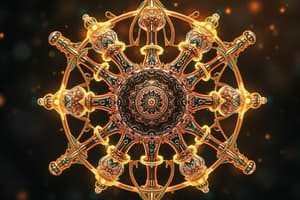Podcast
Questions and Answers
¿Cuál es el centro de un átomo, compuesto por protones y neutrones?
¿Cuál es el centro de un átomo, compuesto por protones y neutrones?
- Electrones
- Molécula
- Átomo completo
- Núcleo (correct)
¿Qué característica de los átomos propuso John Dalton en 1803?
¿Qué característica de los átomos propuso John Dalton en 1803?
- Los átomos son indivisibles (correct)
- Los átomos pueden ser destruidos
- Los átomos son divisibles
- Los átomos no tienen masa
¿Qué_SUcede cuando un electrón salta de un nivel de energía a otro en el modelo de Bohr?
¿Qué_SUcede cuando un electrón salta de un nivel de energía a otro en el modelo de Bohr?
- Se absorbe energía
- Se mantiene la energía
- Se emite energía (correct)
- Se pierde la energía
¿Qué determina la identidad de un elemento en el núcleo atómico?
¿Qué determina la identidad de un elemento en el núcleo atómico?
¿Cuál es el nombre del modelo que propone que los electrones ocupan niveles de energía discretos y distantes alrededor del núcleo?
¿Cuál es el nombre del modelo que propone que los electrones ocupan niveles de energía discretos y distantes alrededor del núcleo?
¿Cuál es la carga de los electrones en el modelo de Rutherford?
¿Cuál es la carga de los electrones en el modelo de Rutherford?
¿Cuál es la principal limitación del modelo de Dalton?
¿Cuál es la principal limitación del modelo de Dalton?
¿Qué es lo que estabiliza el núcleo en un átomo?
¿Qué es lo que estabiliza el núcleo en un átomo?
¿Qué característica de los rayos catódicos es fundamental para su comportamiento?
¿Qué característica de los rayos catódicos es fundamental para su comportamiento?
¿Qué es lo que se descubrió en 1932 y tiene una carga eléctrica neutra?
¿Qué es lo que se descubrió en 1932 y tiene una carga eléctrica neutra?
¿Qué modelo atómico se desarrolló a partir de la observación de los rayos catódicos?
¿Qué modelo atómico se desarrolló a partir de la observación de los rayos catódicos?
¿Cuál es la función principal de los neutrones en las reacciones nucleares?
¿Cuál es la función principal de los neutrones en las reacciones nucleares?
Flashcards are hidden until you start studying
Study Notes
Atomic Models
Dalton Model
- Proposed by John Dalton in 1803
- Key features:
- Atoms are indivisible and indestructible
- Atoms of the same element are identical
- Atoms of different elements have different masses
- Compounds are formed when atoms of different elements combine in small whole number ratios
Rutherford Model
- Proposed by Ernest Rutherford in 1911
- Key features:
- Atom consists of a small, dense nucleus at the center
- Nucleus is surrounded by electrons orbiting at a distance
- Nucleus is positively charged, electrons are negatively charged
- Electrons occupy specific energy levels or shells around the nucleus
Bohr Model
- Proposed by Niels Bohr in 1913
- Key features:
- Builds upon Rutherford's model
- Electrons occupy specific energy levels or shells around the nucleus
- Energy levels are discrete and distinct
- Electrons jump from one energy level to another by emitting or absorbing energy
Atomic Nucleus
- The central part of an atom
- Composed of protons and neutrons
- Protons:
- Positively charged
- Same number in atoms of the same element
- Determines the identity of an element
- Neutrons:
- No charge
- Varies in number among atoms of the same element
- Affects the mass of an atom
Studying That Suits You
Use AI to generate personalized quizzes and flashcards to suit your learning preferences.




